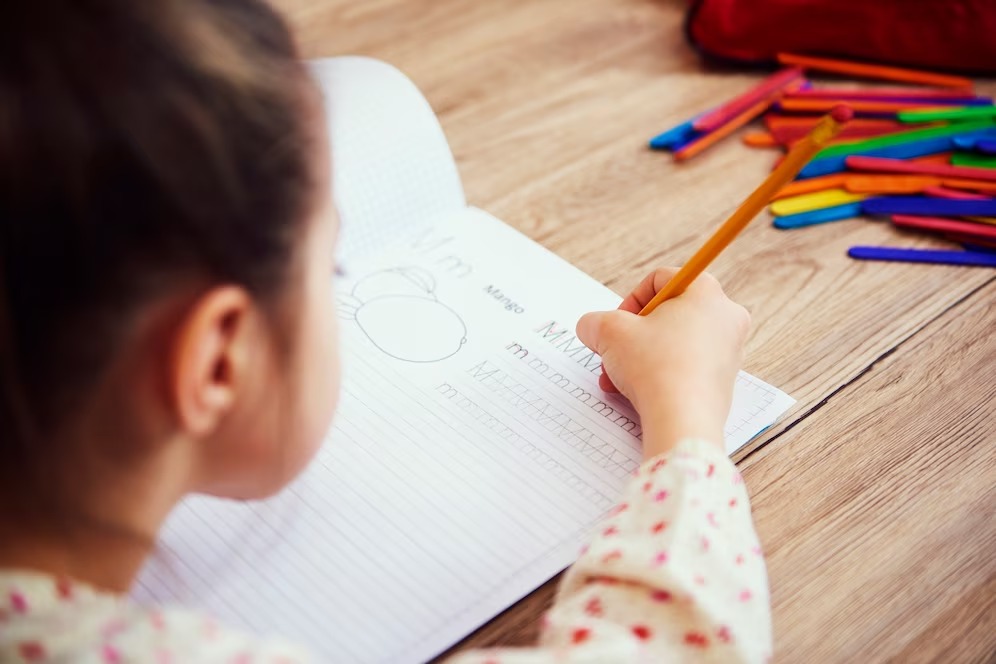When learning how to write in cursive, some things are worth thinking about. Cursive writing offers many advantages that extend to the mental development and intellectual growth of children. It is not only about crafting beautiful letters or elegant aesthetics but also enhances cognitive function and academic performance.
Math & ELA | PreK To Grade 5
Kids see fun.
You see real learning outcomes.
Watch your kids fall in love with math & reading through our scientifically designed curriculum.
Parents, try for free Teachers, use for free
Starting from the position of each letter to the shape of every letter, all possible detail is vital. This form of writing, of course, is a joint writing style. It was commonly used for most of human history until this modern computer age. Not only can learning how to write letters in cursive benefit your child by improving writing skills, but it is also an impressive skill to master!
“Handwriting is the imprint of self on a page.” — Dr. Rosemary Sassoon
Cursive Writing: What is it?
Writing in cursive isn’t just about forming letters; it’s a cognitive workout routine. The letters in cursive script uplift students to create a seamless flow of words in a cohesive and organized written communication form.

When young minds trace the curves and loops of cursive letters, they forge stronger connections within the brain, enhance memory recall and cognitive agility, and stimulate neural pathways in children’s minds.
“Handwriting is a spiritual design, even though it appears by means of a material instrument.” – Euclid
Why Does Cursive Writing Hold a Timeless Significance?
Today, even though digital communication and keyboard typing have taken over the world, the art of cursive writing stands as a timeless testament to the beauty, grace, and elegance of the written word.
It is also a beneficial therapy for individuals with dyslexia because its continuous personal flow of letters reduces the visual and cognitive breaks and creates a comfortable experience for those navigating the written word that can challenge dyslexic readers.
Following are a few benefits why kids should learn how to write in cursive:
“Handwriting is rooted in the spirit, even though it appears by means of bodily senses.”― Al-Nazzam
- Enhanced Cognitive Development
- Elevated Handwriting Skills
- Heightened Reading Comprehension
- Nurturing Patience and Focus
- Distinctive Personal Expression
Related Reading: Amazing Writing Prompt For Kids To Improve Confidence
How to Write A-Z in Cursive in 8 Easy Steps

Learning how to write in cursive is a journey that leads to mastery. It is a skill that holds immense value to date – a series of carefully orchestrated steps, each building upon the previous one to build a foundation of excellent penmanship.
These steps are more than mechanical motions. Let’s find out some steps of learning how to write in cursive handwriting.
1. Familiarize Yourself with Basic Strokes
To learn how to spell in cursive, the first step is to learn basic strokes. It helps to write the flow and form of each character.
- Start practicing upward lines. These lines are the backbone of many lowercase letters. For example, “l,” “b,” and “h.”
- Learn upward lines for letters like – “p,” “g,” and “j.”
- Practice concave and convex curves for letters like – “a,” “c,” and “e.”
- Learn loops. These are used in letters like – “b,” “d,” and “f” to add character.
2. Start with Lowercase Letters
After learning the strokes, focus on lowercase letters. It forms the majority of written words, making them automatically a crucial starting point.
- Start by practicing simpler lowercase cursive letters, as it requires minimal strokes and transitions. For example, “a,” “c,” “e,” and “l.”
- Focus on the correct formation of each letter.
- Practice forming each letter repeatedly. It helps develop muscle memory.
- Maintain consistent letter size along with proportions.
- Start forming simple words.
3. Learn Uppercase Letters
Then comes broadening your skills by learning uppercase cursive letters. It brings a unique dimension to cursive writing. Uppercase cursive letters often have distinct forms. For example, some letters might have loops, curls, or tails, giving them a distinctive cursive appearance.
- Practice individual uppercase cursive letters.
- Start with letters that look like their printed forms, such as “C,” “O,” “V,” and “W,” for a sense of familiarity.
- Get habituated to ligatures such as “th,” “ch,” and “sh.”
4. Practice Letter Connections
Art is not only in its strokes or letters but also in how well it is connected with one another.
Connecting the letters gives cursive writing its iconic flow and charm.
- Focus on creating smooth transitions between letters.
- Avoid disjointedness – the unintended gaps between letters that disrupt the flow.
- Start slowly by paying attention to each transition.
- As these pairs are frequently used, start with connecting “o” to “u,” “r,” to “e,” and “a” to “n,”.
5. Form Basic Words
The next step is to bring individual letters and letter connections together. It helps to create meaningful, and coherent compositions for forming basic words in a better way.
- Start with easy words.
- Use a mix of lowercase and uppercase cursive letters.
- Each letter should naturally flow into the next.
- Use consistent letter size, slant, and spacing.
- For a smoother execution, before writing a word, think about how you will compose it.
- Avoid abrupt changes in direction between letters to maintain an uninterrupted rhythm.
6. Advance to Longer Sentences
To write longer sentences, start by connecting the letters and creating basic words. Enhance your cursive writing skills by writing multiple words into coherent and expressive sentences.
- Write sentences with a clear message.
- Focus on letter size, slant, and spacing across words.
- Use punctuation marks like commas, periods, and question marks.
- Maintain a smooth and natural flow.
- Gradually find your cursive writing style. Try variations. Use letter slants, size, and connections to personalize your cursive script.
7. Explore Ligatures
Ligatures are basically the connections between specific letter pairs seamlessly connecting each other. Some common ligatures include “th,” “ch,” “sh,” and “fi.” It adds a touch of artistry and sophistication to the cursive writing style by enhancing the aesthetic appeal.
- Pay attention to proportions while forming ligatures.
- The transition needs to be smooth and graceful.
- Choose words that naturally include the ligatures.
8. Develop a Consistent Slant
Consistent slant is the soul of cursive writing. It refers to the balanced angle at which letters lean onto each other. A uniform slant throughout your writing makes sure of its visual appeal and professionalism.
- Even if no one-size-fits-all is a core rule, most cursive scripts have a slight slant ranging from 45 to 60 degrees.
- Draw slant lines on a sheet of paper and use them as guides. Using it can be a valuable tool in maintaining a consistent slant.
- Be consistent. Pay attention and maintain a uniform slant across all letters.
9. Experiment with Flourishes
Flourishes add flair and personality with strokes and loops that can turn ordinary words into works of art. It is a unique form of self-expression that helps infuse cursive writing with a touch of elegance and individuality.
- Start by practicing simple flourishes with small loops or curls.
- Strive for a balanced composition by avoiding overwhelming your writing with excessive or overly ornate decorations.
- Use it thoughtfully and purposefully to maintain readability and visual appeal.
- Develop a signature flourish that sets your cursive writing apart.
10. Practice Regularly
Like every other skill, consistent practice reinforces muscle memory and helps to master it. When you practice daily, you’ll witness the evolution of your penmanship and build a style that you can proudly call your own.
- Set aside dedicated time each day, even as little as 10-15 minutes each day, to practice.
- Develop a schedule that works for you.
- Start each practice session by revisiting the foundational strokes, lowercase and uppercase letters, and basic words.
- Practice extra to address any challenges.
Now that we have discussed steps for how to write in cursive handwriting, let’s understand a few tips to help you understand cursive writing better.
Related Reading: How to Improve Handwriting: 10 Easy Tips for Kids
3 Cursive Writing Tips

As children embark on the enchanting journey of cursive writing, it is essential to equip them with the techniques that will nurture their penmanship prowess. Discover below a treasury of invaluable tips that will empower young learners to learn how to write in cursive gracefully.
“Handwriting is the shackle of the mind.”― Plato
1. Use Guided Worksheets
Whether you’re a beginner or looking to refine your existing skills, guided worksheets offer step-by-step guidelines for learning letter formation, connections, and overall script aesthetics.
2. Pay Attention to Spacing
Spacing is a critical aspect of cursive writing. It impacts the readability and overall visual appeal of your writing. Adequate spacing between words makes it easier for readers to separate individual words and easily understand your message by making your writing look aesthetic.
3. Seek Feedback
Striving for feedback is a great habit that directly impacts in improving your cursive writing skills. Constructive criticism from people you trust, for example, your friends, family, teachers, mentors, or even self-assessment, gives an objective overview of your writing.
Related Reading: Best Report Card Comments Samples
3 Benefits of Learning Cursive Writing

The art of cursive writing is a specialized skill that may make writing appear elegant and lead to a more thorough understanding of history. Even though we frequently type on computers and mobile devices, learning to write in cursive has some distinctive and worthwhile benefits, particularly for young people. Let’s understand why it’s so beneficial for children to learn.
1. Writing Faster and Better
After kids have learned the principles of print handwriting, learning cursive allows them to express themselves more quickly on paper. They can concentrate on creating cohesive, readable compositions because of this efficiency, freeing up their cognitive resources.
2. Getting More Creative
Use of cursive writing is beneficial to our brains since it engages both sides of our brains – logical and creative. It improves our memory and linguistic skills, as well as helps in the generation of fresh ideas.
3. Memory Retention
Remembering things is important, and guess what? When we write in cursive, the letters flow together in a unique way, which may help us remember things better. Knowing how to write in cursive may make it easier for kids to recall what they learn.
3 Tools Required for the Perfect Penmanship

Learning cursive writing requires only a few simple tools to get started, but the benefits extend far beyond the basics. Let’s look at the fundamental tools that will help you on your cursive writing journey.
- Paper
- Pencil or Pen
- Cursive Guides
Conclusion
The more you delve into the depths of cursive writing, you will uncover the crucial steps and values that guide young learners to refined penmanship. When you start your journey that transcends mere penmanship – each stroke, curve, and connection forms a tapestry of expression, cognitive growth, and artistic identity.
Through this comprehensive guide, you will learn the art of cursive writing, which is woven together with the threads of history, culture, and personal style. Starting from basic strokes to experimenting with intricate flourishes, each stage teaches how to write cursive letters and helps the master cursive writing with ease.
Related Reading: Best Reading Strategies for Students
Frequently Asked Questions (FAQs)
What are the reasons for children to learn cursive writing?
Learning how to write in cursive holds significant benefits. It helps in building cognitive skills and directly impacts reading comprehension. It engages their brain in intricate hand movements and neural connections that contribute to improved brain development and intellectual growth.
When is the appropriate age for children to begin learning cursive writing?
According to experts, the age of 7 or 8 is often a suitable time for kids to start learning cursive writing because children typically get the fine motor skills that are needed to control a pen or pencil with more precision.
























